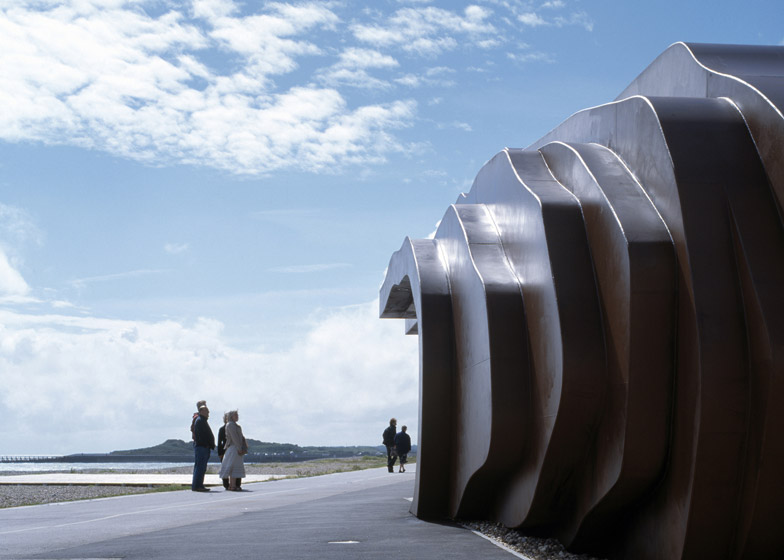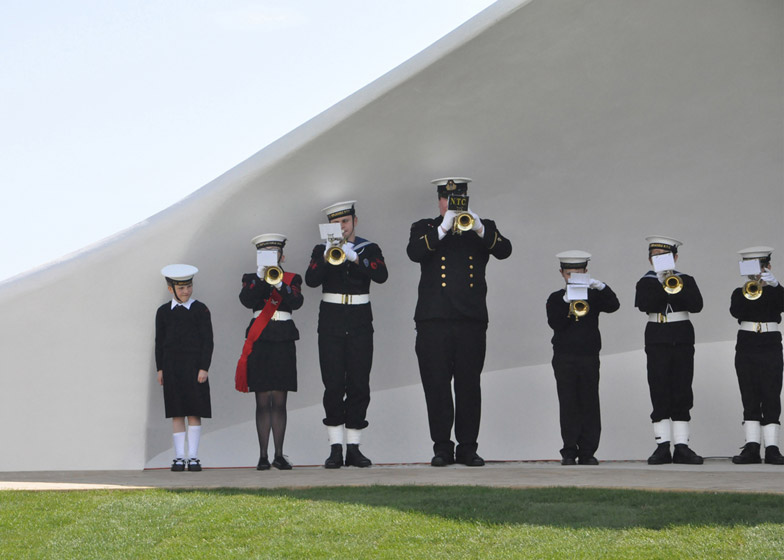Littlehampton now boasts more headline-grabbing design than many cities, with projects by Thomas Heatherwick, Asif Khan and others. Dezeen tracked down the woman who spread architecture through the coastal town "like a contagious disease" (+ slideshow + interview).
The small resort on England's south coast has a population of just 55,000, but its seafront now features four landmark structures including East Beach Cafe, the first permanent building by Thomas Heatherwick.
The latest, a pair of shelters by architects Flanagan Lawrence, opened this week, joining another cafe by architect Asif Khan and a 324 metre-long bench by Studio Weave.
All four projects are down to one woman: property developer Jane Wood, who bought a weekend house in the town in 2007 and set about transforming the then lethargic resort though architecture.
"A building came up for auction which nobody bid for," Wood told Dezeen. "It was opposite the site where East Beach Cafe is now. It was very, very cheap."
Shortly after that Wood noticed that the council had approved plans to replace a food kiosk on the promenade in front of her house with a burger restaurant.
"It was a very unspectacular building, so I decided Littlehampton needed something better," she said. "So I bought the chippy."
A chance meeting with Thomas Heatherwick led to the creation of East Beach Cafe, a long, thin crustacean-like restaurant facing the sea.
Wood met Heatherwick at a birthday party and told him about her Littlehampton project. She was surprised to hear that the designer knew the little town. "He said: 'I have walked along that promenade and bought ice cream at that kiosk. Please may I design your building?' And that's how it started."
"Jane was an incredible client," Heatherwick told Dezeen, describing his design as a "wiggling brown non-object".
"It's a town full of people who have retired and are not known for experimental ideas," he said. "If you showed a drawing of a wiggling brown object to people, they might think it looked like other types of brown object."
"But Jane stuck to it, she worked in the kiosk and would pull out the drawing and show it to people and explain it. And when it came to the planning application we had nothing but letters of support from people who we thought would be against it. She was a phenomenon."
Since then, architectural projects have spread across the town like a virus according to Clare Potter, project manager at Littlehampton Town Council.
"In some ways it's like a contagious disease," Potter said. "Jane Wood started it with East Beach and you just can't put a conventional piece of architecture next to something iconic like that."
The restaurant, together with Wood's next project, the Long Bench, started drawing visitors to the West Sussex town, which in turn helped persuade the council to fund more projects.
"When the Long Bench came about it was just very exciting and it was so successful in drawing attention to our little seaside town," said Potter. "So we decided to follow the route through and do it properly by organising a design competition [for the shelters] to see who could come up with a design that fits in with the rest of the architecture."
"I don't think we have a choice now, we're on a roll," she added. "We've got all sorts of ideas, so watch this space."
Wood believes that her interventions have changed the town for the better. "It has bought people to Littlehampton who tell me they would never come there if it weren't for me," she said. "And that is what I've set out to do: to regenerate the place, and bring it a different kind of person, and that has happened."
Below is an edited transcript of the interview with Wood:
Alyn Griffiths: How did you discover Littlehampton?
Jane Wood: I do property development. I'd been to Littlehampton with my father and rather liked it. A building came up at auction which nobody bid for, opposite the site where East Beach Cafe now is. My business partner and I bought it between us in 2007 - it was very, very cheap.
Alyn Griffiths: Why did you develop the restaurant?
Jane Wood: A few months after having bought [the house] we noticed that the tiny fish-and-chip kiosk in front of us had got planning permission for a ninety-seat burger restaurant. It was a very unspectacular building, so I decided Littlehampton needed something better. So I bought the chippy.
Alyn Griffiths: How did you get Thomas Heatherwick on board?
Jane Wood: I went to Wilfred Cass' birthday party at the Cass Sculpture Foundation. Thomas Heatherwick sat next to me. He asked me what I was doing and I told him about the project in Littlehampton.
He told me he knew the chippy because local metal fabricator Littlehampton Welding built his Rolling Bridge in Paddington Basin. He said: "I have walked along that promenade and bought ice cream at that kiosk. Please may I design your building?" And that's how it started.
Alyn Griffiths: Did you consider other designers for the restaurant?
Jane Wood: I'd looked at other architecture work and I couldn't really see an architectural solution to the site. I instantly knew that Thomas could do something great for it because I just knew what he would bring to it would be something spectacular. So that's how the cafe restaurant came about.
Alyn Griffiths: What kind of brief did you give Thomas?
Jane Wood: Thomas's response to a brief is amazing. He's fantastic to work with – he's a genius, an absolute genius. I told him I’d allow him as much artistic license as is commercially viable. I've never run a restaurant before but I realised that if you want a good restaurant team you have to have an all-round facility, because good staff want a permanent job.
So we had to have an all-weather facility, which is why I couldn't imagine a very modern structure there because it would be too open. Thomas said he wanted a view to the beach, but he didn’t want a view of the [townscape] behind because it was too varied. And he wanted to create a refuge within it. And that's how we came to that design. In the winter it's cosy. People come all year round.
Alyn Griffiths: What sort of reaction did you get from locals when the restaurant opened?
Jane Wood: It was very varied. Generally elderly residents, the sort of people who you would think won't like it, don't.
Alyn Griffiths: What was the next project?
Jane Wood: Then the bench came about. At the time when we opened the restaurant [Body Shop founder] Anita Roddick [who was born in Littlehampton in 1942 and died in 2007] was alive and she'd done a lot of work in Littlehampton. My daughter Sophie had the idea to build a bench along the promenade which would be a tourist attraction, and we spoke to Anita about it and she said she would fund it.
So we set about finding a designer. Peter [Murray, Jane's husband] introduced me to Studio Weave, and Albert Taylor [of structural engineer Adams Kara Taylor] who did the engineering for East Beach Cafe. He helped get the project off the ground.
Alyn Griffiths: What about Asif Khan's West Beach Cafe?
Jane Wood: I'd seen the work of [architect] Asif Kahn, who I think is brilliant. He'd done some refugee housing in Thailand and a very nice awning over a favela in South America. I commissioned him to do West Beach Cafe.
Alyn Griffiths: And now the latest project, Acoustic Shells by Flanagan Lawrence, has been completed. Tell us how that came about.
Jane Wood: The council were talking to me about buying a replica bandstand. I said: "What on earth do you want to do that for? You will get old people listening to the town band. You won't get different kinds of acts."
I said: "What you want to do is build on the modernity that we've now established on the promenade in Littlehampton, and use it. Don't call it a bandstand, call it a stage by the sea and then you will attract young people, which is what Littlehampton needs."
So Peter organised an architectural competition and the council were staggered by the response. It's very nice and I gather it's up for an architecture award.
Alyn Griffiths: Are you working on any other projects in the town?
Jane Wood: I bought the very last remaining Victorian warehouse on the east bank [of the River Arun that runs beside the town]. It was the last bit of marine history on the riverbank and I've built five houses there [designed by architect John Pardey]. And I've bought the site next door to the last remaining bit of the warehouse.
Alyn Griffiths: You've really transformed the whole place then.
Jane Wood: [laughs] It has brought people to Littlehampton who tell me they would never come there if it weren't for me. And that is what I've set out to do: to regenerate the place, and bring it a different kind of person, and that has happened.
















